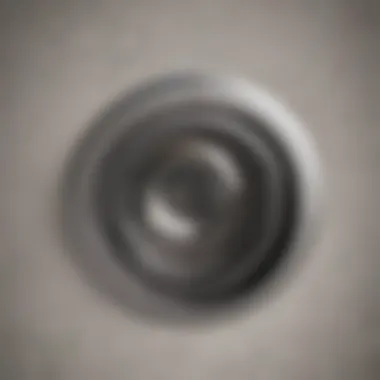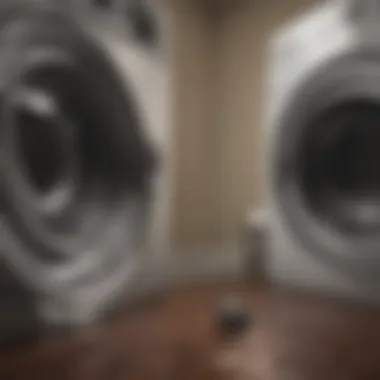Essential Tips for Effective Dryer Vent Cleaning


Intro
Maintaining a dryer vent is an essential task that often gets overlooked in many households. Homeowners might underestimate the risks associated with a clogged vent. Dryer vents are not only vital in ensuring efficient appliance operation but also play a significant role in home safety. Clogged dryer vents can lead to increased drying times, greater energy consumption, and they pose fire hazards.
Cleaning a dryer vent involves several steps, and having the right tools is critical. In this guide, we'll walk through the process of cleaning your dryer vent, the conditions that can affect its performance, and the safety precautions that need to be observed. By understanding the importance of this maintenance task, you can ensure your home is safe, efficient, and energy-friendly.
Understanding Dryer Vents
Dryer vents are composed of a duct that channels escaped air from the dryer to the exterior of your home. Over time, lint and debris can accumulate, which can obstruct airflow. This restriction leads to overheating, increased energy consumption, and can create a potentially dangerous situation. To prevent these issues and enhance the dryer’s performance, regular cleaning is required.
"Neglecting dryer vent maintenance can drastically reduce the appliance’s lifespan and increase utility bills."
Overview of This Guide
This guide will provide a comprehensive overview consisting of:
- The importance of maintaining clean dryer vents.
- Detailed steps for effectively cleaning your dryer vent.
- A list of tools you will need for this task.
- Safety precautions that are crucial for avoiding hazards.
By the end of this guide, homeowners and those interested in home maintenance will possess a well-rounded understanding of dryer vent care. This will not only contribute to a healthier home environment but also enhance the performance of their dryer.
Prelude to Dryer Vent Cleaning
Dryer vent cleaning plays a critical role in maintaining home safety and appliance efficiency. Many homeowners overlook this aspect of household maintenance, often unaware of the potential hazards that arise from neglected vent systems. This section aims to emphasize the significance of regularly cleaning your dryer vent and highlight the numerous benefits this task can bring.
Understanding the Importance of Dryer Vent Maintenance
Dryer vents, when clean, help facilitate the proper functioning of the dryer. This ensures that clothes dry in a reasonable time and that the appliance does not consume excessive energy. In fact, a well-maintained vent can improve energy efficiency significantly, which translates to lower utility bills. Moreover, an operational dryer creates less wear and tear on the machine, potentially extending its life.
Neglecting vent cleaning, however, introduces multiple risks. Over time, lint accumulates in the vent, creating a fire hazard. According to the National Fire Protection Association, failure to clean dryer vents is a leading cause of home fires associated with dryers. Thus, regular maintenance not only protects property but also safeguards lives.
Common Problems Associated with Clogged Vents
Clogged dryer vents manifest in various signs that extend beyond longer drying times. Some common problems include:
- Excessive Heat: If the exterior of the dryer feels hot to the touch, it may be a sign that the vent is blocked. This heat buildup can lead to overheating and eventually damage the dryer.
- Burning Smell: Lint accumulation can lead to a burning smell during operation. This scent should not be ignored and indicates a need for immediate attention.
- Increased Drying Time: If clothes are taking longer to dry than usual, this underscores a clog in the vent. This affects both the performance and efficiency of the dryer.
- Visible Lint Around the Dryer: If you notice lint accumulation around the dryer, this suggests that there may be an obstruction preventing proper airflow.
Ignoring these signs can result in severe consequences, such as appliance failure and fire hazards. Keeping a keen eye on your dryer vent's condition is essential for both safety and efficiency, warranting regular maintenance as an integral part of home upkeep.
Identifying the Right Time to Clean the Dryer Vent
Cleaning your dryer vent is not just an occasional task; it's essential for maintaining the appliance's efficiency and safety. Knowing when to clean is critical for preventing potential hazards and ensuring optimal performance. By recognizing the signs of a clogged dryer vent, homeowners can avoid issues that arise from neglecting this crucial maintenance task.
When the dryer vent becomes obstructed, it can lead to a range of problems. These include increased drying times, higher energy bills, and a higher risk of fire. Therefore, understanding the timing and the signals indicating a need for cleaning should be a priority for every homeowner.
Signs of a Clogged Dryer Vent
Several indicators reveal when a dryer vent requires cleaning.
- Longer Drying Times: If clothes take longer than usual to dry, it might mean the vent is clogged.
- Burning Smell: This can be serious; if you smell something burning when the dryer is running, stop it immediately and check.
- Hot Dryer or Room: A dryer that is unusually hot to the touch may signal restricted airflow due to a blockage.
- Excess Lint Accumulation: An excess of lint around the dryer or in the lint trap may indicate a more significant problem.
- Dryer Stops: If the dryer frequently stops mid-cycle, there may be some airflow restriction.
Recognizing these signs early can prevent a minor issue from developing into a costly and dangerous one.
The Recommended Cleaning Schedule


Establishing a routine cleaning schedule for your dryer vent can enhance its longevity and effectiveness. It is generally recommended to clean the dryer vent at least once a year. However, certain factors may necessitate more frequent cleanings.
- Usage Frequency: If you use your dryer multiple times a week, consider cleaning it every six months.
- Family Size: Larger households that generate more laundry may need to clean their dryer vents more often.
- Type of Fabrics: Certain fabrics tend to shed more lint, increasing the need for regular cleaning.
“Maintaining a regular cleaning schedule not only prevents clogs but also ensures energy efficiency and reduces fire risks.”
Ultimately, being proactive about dryer vent cleaning can save homeowners from embarking on expensive repairs and ensure a safer laundry experience.
Necessary Tools and Equipment for Cleaning
Cleaning the dryer vent is an essential task that requires the right tools and equipment. Using proper tools not only makes the cleaning process more efficient but also ensures safety during the operation. Without the correct equipment, you might risk damaging your dryer or venting system.
When it comes to dryer vent cleaning, certain tools are indispensable. A thorough understanding of what is needed can save homeowners time and effort, making the cleaning process more straightforward.
Essential Cleaning Tools
Several tools are crucial for effective dryer vent cleaning:
- Vent Cleaning Brush: A vent cleaning brush is designed specifically to reach deep into the vent duct and remove lint buildup. It usually has a flexible long handle to help navigate bends in the ductwork.
- Vacuum Cleaner with Hose Attachment: A vacuum with a hose attachment will assist in sucking up debris and lint from both the vent and the dryer. A shop vacuum is often more effective due to its powerful suction capability.
- Screwdriver Set: A set of screwdrivers, particularly flathead and Phillips head, will be necessary for disassembling sections of the ductwork. This will allow for thorough cleaning of each part.
- Safety Goggles and Mask: Protective eyewear and a mask are important to prevent inhalation of dust and lint particles that might become airborne during cleaning. This ensures your safety as you perform the task.
- Duct Tape: Duct tape can be useful for sealing any gaps or ensuring that sections of duct that were disassembled are securely fastened after cleaning.
Each of these tools offers specific benefits, ensuring that the vent cleaning is effective and safe. Having the right tools on hand will mitigate risks and enhance the overall process.
Alternative Solutions for DIY Enthusiasts
For those who prefer a hands-on approach to cleaning, there are several alternative solutions to consider. Not everyone may have access to the tools mentioned above, but creativity can provide makeshift solutions:
- Lint Removal Kit: These kits are available at most hardware stores. They include a brush and adapter specifically designed for cleaning dryer vents, and they can be a good investment for DIY enthusiasts.
- Flexible Dryer Vent Cleaning Kit: This kit consists of flexible rods that can be attached to a drill. It allows for thorough cleaning without disassembling the vent, providing an efficient cleaning method for those unaccustomed to intricate disassembly.
- Household Items: In case you don't have professional tools, use an old broom handle or a heavy-duty wire hanger to dislodge lint. While this may not be as efficient as commercial tools, it can help in a pinch.
- Turn to Online Communities: Platforms like Reddit have vibrant discussions on DIY tips. Engaging with others who have tackled similar projects can yield practical advice and creative solutions to cleaning dryer vents.
Regardless of what tools or methods you choose, proper maintenance is indispensable for safety and efficiency in your home. Selecting the right equipment based on your personal circumstances will lead to a more successful cleaning experience.
Step-by-Step Guide to Cleaning the Dryer Vent
Cleaning the dryer vent is a crucial process to maintain home safety and efficiency. A clean vent helps prevent fires, improves drying performance, and reduces energy consumption. Understanding the detailed steps involved can significantly enhance the effectiveness of this task, ensuring that your home environment remains healthy and safe. This guide outlines each necessary step, providing clarity for homeowners and design aficionados alike.
Preparation Before Cleaning
Before starting, preparation is an essential phase. Ensuring your space is ready can prevent accidents and improve the cleaning process. Here are some steps to follow:
- Gather Required Tools: You will need a vacuum cleaner with attachments, a screwdriver, and a lint brush.
- Clear the Area: Remove any items around the dryer and the vent. This ensures safety and allows easy access.
- Read the Manual: Familiarize yourself with the dryer model and its parts for effective disassembly.
Disconnecting the Dryer Safely
Safety is paramount during this process. Disconnecting the dryer should be done carefully to avoid potential hazards. Follow these steps:
- Unplug the Dryer: Always pull the plug from the outlet to prevent electric shock.
- Turn off Gas Supply: If your dryer is gas-powered, turn off the gas valve.
- Move the Dryer: Carefully move the dryer away from the wall to access the vent.
Disassembling the Dryer Vent
Now, you need to access the vent duct. This requires careful disassembly of parts. Here’s how:
- Remove the Vent Hose: Loosen any clamps and pull the hose off the dryer.
- Inspect for Damage: Check both ends of the vent for cracks or blockages.
- Note the Configuration: Remember or take a picture of how everything connects to simplify reassembly.
Using a Vacuum Cleaner Effectively


A vacuum cleaner is key to effective vent cleaning. Here are some tips:
- Use Attachments: Employ narrow nozzles to reach deep into ducts.
- Suction Technique: Move the vacuum slowly throughout the duct to dislodge lint build-up.
- Repeat if Necessary: Go over the same areas multiple times for thorough cleaning.
Cleaning the Vent Duct
Cleaning the duct itself is the next vital step. Ensure you do this methodically:
- Brush the Duct: Use a lint brush to dislodge any remaining debris stuck to the duct walls.
- Inspect for Blockages: After brushing, check for any significant clogs that may require larger tools.
- Ensure Airflow: Confirm that air flows freely by performing a simple airflow test after cleaning.
Reassembling the Dryer Vent
After cleaning, putting everything back together ensures your dryer functions correctly:
- Reattach the Vent Hose: Securely connect the vent hose to the dryer.
- Recheck Clamps: Make sure all clamps are tightened properly to prevent air leaks.
- Push Dryer Back in Place: Carefully position the dryer back against the wall, ensuring not to kink the vent.
Cleaning your dryer vent doesn’t have to be an overwhelming task. By following these organized steps, you can effectively maintain your dryer, enhance its performance, and contribute to a safer living environment. Taking the time to perform this essential maintenance regularly helps preserve the integrity of your appliance and ensures that your home remains a safe place.
Safety Precautions During the Cleaning Process
Cleaning a dryer vent is essential for maintaining safety and efficiency in your home. In this section, we will cover the safety precautions to consider while performing this necessary task. Understanding these precautions can prevent accidents and ensure the best results during the cleaning process.
General Safety Practices
When you set out to clean your dryer vent, certain general safety practices should be followed:
- Unplug the dryer: Always disconnect the dryer from the power source to eliminate the risk of electrical shock.
- Use the right tools: Ensure you have the appropriate tools readily available, such as screwdrivers, a vacuum cleaner, and lint brushes. This prevents last-minute scrambles that could lead to accidents.
- Wear protective gear: Safety goggles, gloves, and a dust mask can protect your eyes, skin, and lungs from dust and debris.
- Ensure proper ventilation: Cleaning indoors can stir up fine dust and lint. Open windows or use a fan to maintain good airflow during the cleaning process.
These practices create a safer environment for you and minimize the risks associated with working with appliances.
Avoiding Common Hazards
Cleaning your dryer vent may expose you to specific hazards. Recognizing and avoiding them is crucial:
- Lint buildup: Accumulated lint is highly flammable. Ensure that you clean not just the vent ducts but also the lint trap and the surrounding areas.
- Sharp edges: Disassembling the vent may expose sharp metal edges. Exercise caution while handling these components to prevent cuts or injuries.
- Heavy lifting: If you need to move your dryer for access to the vent, ask for help. Lifting heavy appliances alone can cause back strain or injuries.
- Static electricity: Consider wearing rubber-soled shoes to prevent static discharge while cleaning, particularly when handling electrical components.
By effectively avoiding these hazards, you can minimize risks and create a safer working environment.
"Regular maintenance reduces the risk of fire hazards tied to dryer vents, improving both safety and efficiency."
Observing safety precautions during the cleaning process not only protects you but also enhances the efficiency of your dryer, paving the way for successful maintenance.
After-Cleaning Maintenance Tips
Keeping your dryer vent clean is only one part of an ongoing maintenance strategy. After cleaning, there are specific action steps and considerations that can significantly enhance dryer performance and safety over time. Identifying the right practices will help ensure consistent functionality while also preventing any potential hazards.
Monitoring Dryer Performance Post-Cleaning
Once you have finished cleaning your dryer vent, it is critical to monitor its performance closely. Begin by paying attention to how long it takes for your clothes to dry. If you notice an increase in the drying time, it may indicate that there are still blockages or that an issue has emerged elsewhere in your dryer system.
Another key performance indicator is unusual noises during operation. If the dryer starts to make rattling or squeaking sounds, it might be time to inspect the dryer more thoroughly. This includes checking the venting system again and looking for any signs of wear or obstruction.
Additionally, you could perform a moisture test. After a drying cycle, check your clothes; they should be thoroughly dry without any dampness. If you experience ongoing issues, it might be wise to contact a professional for deeper inspection, as this may indicate more severe problems.


Long-Term Maintenance Strategies
Establishing a long-term maintenance plan for your dryer vent is essential to prolong its efficiency and lifespan. Here are a few strategies to consider:
- Regular Inspections: Schedule inspections at least once a year to identify any buildup of lint or other debris. This will help prevent any serious blockages from forming.
- Use Dryer Lint Screens: Replace or clean lint screens frequently to minimize lint buildup in the outer ducts.
- Clear the Area: Make sure the area around the dryer is free of clutter. This makes it easier to access the appliance and reduces the risk of lint igniting.
- Ventilation Improvement: Evaluate the dryer’s ventilation path. Long, twisting ducts can trap more lint. Aim for straight, short duct runs wherever possible.
- Consider Upgrading: If your dryer or its venting system is old or inefficient, explore upgrading to newer models that offer better energy efficiency and built-in safety features.
By incorporating these practices into your routine, you will enhance not only the safety and efficiency of your dryer but also contribute positively to your overall home maintenance.
"Regular maintenance is key to preventing future issues and ensuring your dryer operates efficiently."
By adhering to these after-cleaning maintenance tips, you will undoubtedly ensure that your dryer continues to function efficiently while reducing the risks associated with dryer vent issues.
Professional Cleaning Services: When to Consider Them
Cleaning your dryer vent is a task often delayed, but sometimes, it demands more expertise than a simple DIY approach. Understanding when to call in a professional service is vital. Homeowners should assess their situations based on certain criteria, including the degree of blockage, the age of the appliance, and previous cleaning frequency. While maintaining the dryer vent can be manageable, there are points where professional help becomes an essential aspect of home maintenance.
Benefits of Professional Assistance
Engaging a professional cleaning service can yield several benefits.
- Thorough Inspection: Experts can identify issues beyond just lint accumulation. They have the experience to see potential problems like ventilation issues and appliance malfunctions that a homeowner might miss.
- Specialized Equipment: Professionals come with tools designed specifically for cleaning dryer vents. This equipment often performs more thoroughly than standard household tools, ensuring a cleaner and safer vent system.
- Time Efficiency: While cleaning a dryer vent may take a weekend for an amateur, professionals can often complete the job in a fraction of the time. This provides homeowners peace of mind, knowing the job is done correctly and swiftly.
- Safety Assurance: Clogged dryer vents pose fire hazards. Professionals can ensure that the cleaning is done safely, mitigating risks associated with improper removal of lint.
Overall, professional services can provide a comprehensive solution to dryer vent maintenance, ensuring the system operates optimally and safely.
Choosing a Reliable Service Provider
Selecting the right professional for cleaning your dryer vent is crucial. Here are some strategies to help you find a reputable service.
- Recommendations and Reviews: Seek referrals from friends or family, or check online reviews. Websites like Reddit or Facebook can offer insights into various service providers based on real experiences.
- Certifications and Insurance: Ensure the company is certified and insured. This protects you from liability in case of accidents during the cleaning process.
- Transparent Pricing: A reliable provider will give a clear estimate, outlining services and costs upfront. Avoid any services that present vague pricing information.
- Experience and Expertise: Inquire about the technician's experience. A long-standing company likely has knowledgeable staff.
"Choosing the right professional can save time, prevent issues, and ensure safety in your home."
When it comes to maintaining the efficiency and safety of your dryer, knowing when to call for professional help can make all the difference. By thoroughly vetting potential providers, you can safeguard your home and ensure that your dryer operates within its safe parameters.
The Environmental Impact of Dryer Vent Maintenance
Understanding the environmental impact of dryer vent maintenance is crucial for homeowners who value sustainability as well as safety. Neglecting this aspect can lead to various issues that affect not only personal residences but also the broader community and environmental health.
Energy Efficiency Considerations
One significant benefit of maintaining clean dryer vents is improved energy efficiency. When the vent is blocked by lint and debris, the dryer must work harder to push air through, which leads to increased energy consumption. This inefficiency contributes to higher utility bills, creating unnecessary expenses. Moreover, increased energy use translates to a larger carbon footprint.
It is vital to regularly inspect and clean the dryer vent to ensure optimal airflow. This ensures the appliance operates efficiently, thereby reducing energy waste. Homeowners can consider investing in energy-efficient dryers that come equipped with features designed to minimize power consumption. For example, smart dryers often have sensors that detect moisture levels and adjust drying cycles accordingly. Therefore, maintaining a clean dryer vent and choosing energy-efficient appliances can lead to significant savings and a reduced environmental impact.
Waste Reduction through Regular Maintenance
Regular maintenance of dryer vents also contributes to waste reduction. Lint that accumulates in vents and filters does not simply vanish; it creates waste that may contribute to pollution if improperly discarded. By reducing lint buildup through consistent cleaning, homeowners can minimize such waste. Additionally, dryer vents that are kept clean are less likely to cause dryer malfunctions, prolonging the lifespan of the appliance and reducing the need for replacements.
"Regular maintenance is critical not only for safety but also for sustainable living practices. Keeping your dryer vents clean fosters energy conservation and waste reduction."
Closure
The conclusion serves a significant role in encapsulating the crucial elements discussed throughout the article. It is the part where readers reflect on the process of dryer vent cleaning, and why it matters in the broader scope of home maintenance and safety. Cleaning a dryer vent is not merely a chore; it is an investment in your home's health and efficiency. In a society that increasingly prioritizes safety and environmental considerations, understanding the implications of neglected dryer vents becomes vital.
Recap of Key Points
- Importance of Cleaning: Regular maintenance of dryer vents helps prevent potential fires caused by lint buildup, as well as ensures optimal energy efficiency.
- Signs of Clogs: Recognizing the signs of a clogged dryer vent—like longer drying times or a burning smell—is essential for timely action.
- Safety Practices: Adhering to safety precautions during cleaning prevents injuries and ensures the process goes smoothly.
- Professional Assistance: Knowing when to seek professional services can save time and enhance the effectiveness of the cleaning effort.
- Environmental Impact: Maintaining clean vents contributes positively to energy conservation and waste reduction practices.
Final Thoughts on Dryer Vent Cleaning
Clean dryer vents lead to better appliance efficiency, lower electricity bills, and peace of mind. Ignoring this task may lead to severe consequences, making it clear that regular vent cleaning should not be an afterthought but rather a scheduled part of your home upkeep. The benefits are evident, and the task itself is straightforward—so commit to it.







